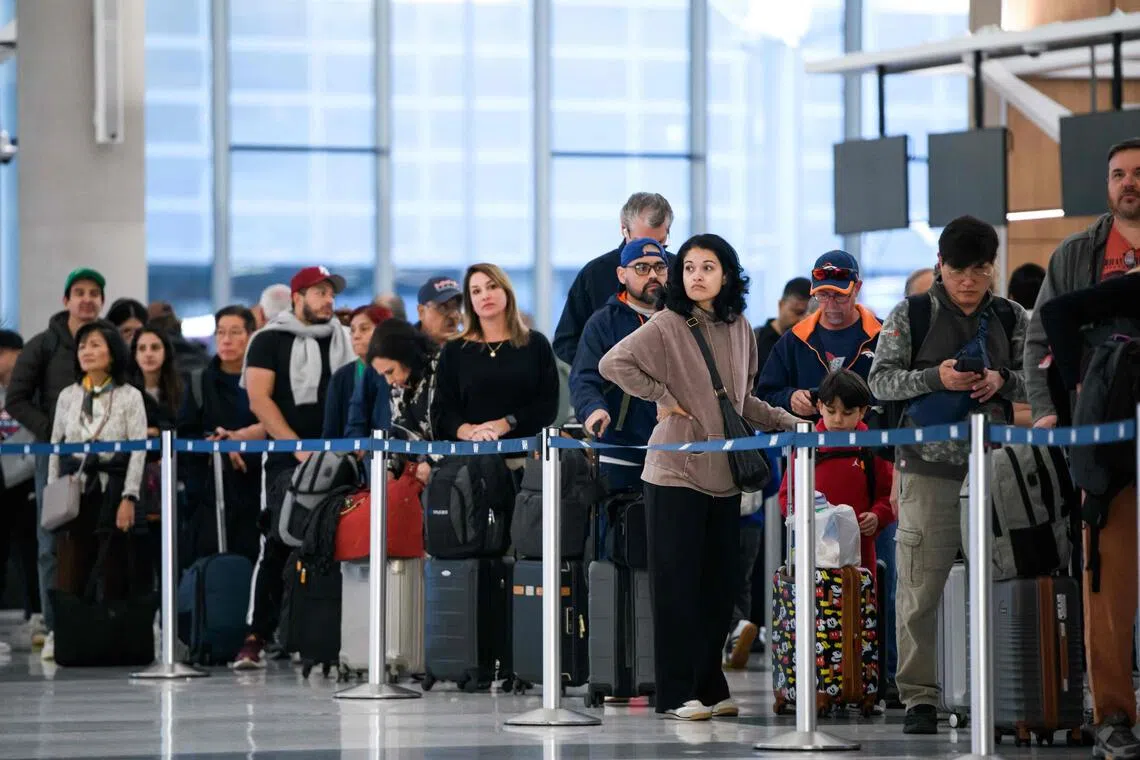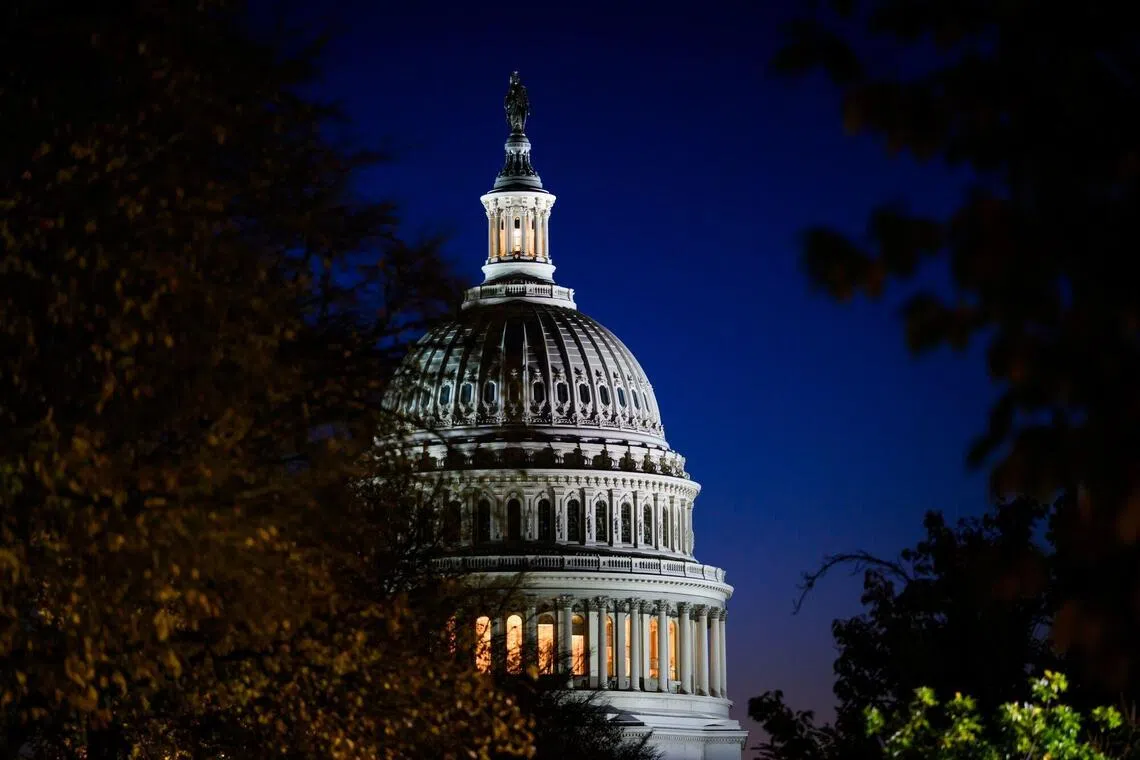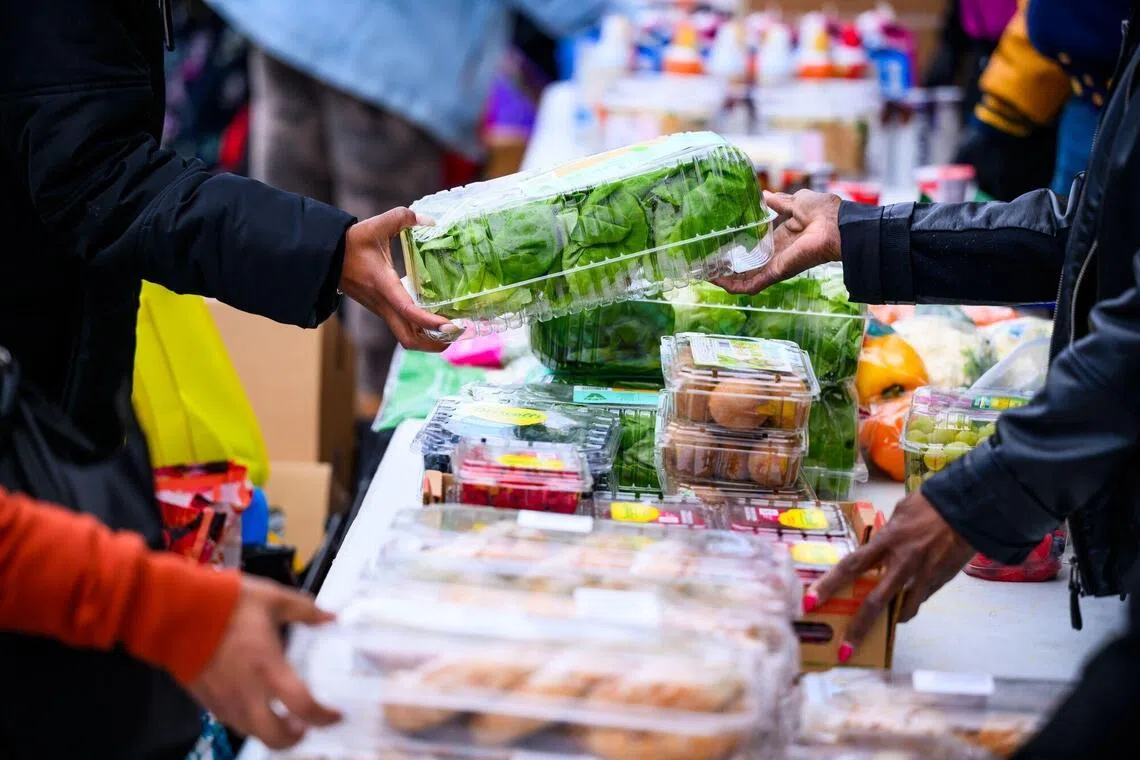Longest US govt shutdown tests air travel, federal workers and patience
Sign up now: Get ST's newsletters delivered to your inbox

With the US government shutdown entering its second month, lines at airports are expected to grow.
PHOTO: AFP
Follow topic:
WASHINGTON – The US government has reached a major milestone of dysfunction as Congress has allowed a federal shutdown to drag into its 36th day – the longest in history
As the stand-off continues, the economic pain is deepening.
Budget manoeuvres to pay active-duty troops and partially fund food aid will likely run out before the end of November. Air traffic controllers working without pay are dropping out at higher rates as one of the busiest travel periods of the year approaches.
And policymakers could be working with flawed or missing data
Economists say the shutdown is beginning to leave a permanent scar. The Congressional Budget Office estimates the shutdown will cut fourth-quarter growth by as much as 2 percentage points if it continues for eight weeks, followed by a short-term rebound early in 2026. Even then, the economy would lose billions in output.
About 600,000 federal employees are working without pay, 650,000 more are furloughed, and unemployment could rise by 0.4 of a percentage point if all furloughed employees are counted as temporary layoffs.
The shutdown hit the longest-ever milestone hours after Democrats landed a series of electoral wins in the New Jersey and Virginia gubernatorial races and in the New York City mayoral contest. President Donald Trump blamed the GOP losses – in part – on the ongoing impasse in Washington.
The shutdown has gone on for so long that it is now about two weeks from outlasting the House-passed Bill that would have kept the government funded through Nov 21. That means even if lawmakers were to quickly negotiate an end to the shutdown – an outcome that still appears unlikely – Congress would imminently face a new funding lapse threat.
Senate Majority Leader John Thune said the Nov 21 date is “going to have to change” in any new Bill to reopen the government to ward off that possibility.
Seasonal shutdown
Government functions that most Americans can live without for a few days or weeks become more critical when they are down for a month and counting.
At the Centres for Disease Control and Prevention, the shutdown has darkened the agency’s FluView dashboard, which tracks weekly flu, Covid-19 and RSV data, and halted publication of the Morbidity and Mortality Weekly Report, a mainstay for epidemiologists worldwide. The gap comes just as the season for respiratory illnesses begins.
About 85 per cent of the employees in the Education Department’s Office of Federal Student Aid have been furloughed, and financial aid applications known as the Fafsa could be held up as college application season reaches its peak.
Businesses and individuals who filed extended-deadline tax returns in October will likely face delays receiving their refunds.
Other applications to bring regulated products to market – everything from new prescription drugs to seasonal Christmas ales – are also on hold.

The ongoing US government shutdown is now tied for the longest in history.
PHOTO: BLOOMBERG
Air travel
It was mounting flight delays that helped put pressure on Congress to end a 35-day shutdown in January 2019. That shutdown – caused by a stand-off over Mr Trump’s request to fund a wall on the US-Mexico border – is now the second-longest in history.
That pattern has begun to repeat itself, as unpaid air traffic controllers begin to take unscheduled time off and staff shortages prompt the Federal Aviation Administration to slow arrivals and departures.
Late last week was particularly hectic, with major US airports from Boston to Texas experiencing problems
Transportation Secretary Sean Duffy said on Nov 3 he would “shut the whole airspace down” if flying becomes unsafe, though he said the US “isn’t there yet”.
The Sunday after Thanksgiving – which in 2025 will hit on Nov 30 – is historically the busiest day for the nation’s airports.
Food stamps
The Trump administration told a federal judge on Nov 3 that it will comply with an order to restore half of November’s Supplemental Nutrition Assistance Programme benefits, using the US$4.65 billion (S$6 billion) remaining in its contingency fund. That will cover only about half of the normal monthly food stamp payments for 42 million Americans.
Agriculture officials warned that recalculating partial payments could take “anywhere from a few weeks to up to several months”. Two judges, in Rhode Island and Boston, ruled that suspending the programme outright likely violated federal law.

Volunteers distribute donated food items to furloughed federal workers at a distribution site in Maryland.
PHOTO: BLOOMBERG
Blame game
Public opinion largely mirrors past showdowns: 45 per cent of voters blame Republicans for the shutdown and 33 per cent blame Democrats, according to an ABC News/Washington Post/Ipsos poll, a smaller gap than in 2019 but consistent with historical trends.
House Democratic Leader Hakeem Jeffries said Democrats are unified in demanding a full reopening of government. “Our position as Democrats remains the same – and will continue to be our position,” he told reporters on Nov 3.
House Speaker Mike Johnson countered that Republicans have voted more than a dozen times to fund the government, while Democrats have blocked each attempt in the Senate.
“It’s the most extreme example of gaslighting in the history of American politics,” he said.
Off ramps
With both sides dug in, it could take external pressure from voters or an extraordinary procedural manoeuvre to end the stalemate.
Mr Trump has renewed his call for Senate Republicans to use what is called the “nuclear option” – ending the century-old filibuster
Democratic New Jersey Senator Andy Kim said the beginning of open enrolment for subsidised health plans could provide the necessary pressure, if senators hear anger over sticker shock.
And then there were the Nov 4 elections, which buoyed Democrats Abigail Spanberger to the governor’s mansion in Virginia and Ms Mikie Sherrill to lead New Jersey. Mr Zohran Mamdani – whom Mr Trump has called a “lunatic” – won the New York City mayoral race
Democrats – after losing to Mr Trump a year ago – found results focusing on affordability, a message that is also reflected in their shutdown demands: lower health care costs in exchange for their support to re-open the government.
Mr Trump expressed his displeasure with the losses, blaming the shutdown – and that his name was not on the ballot – for the Republican defeats. BLOOMBERG

